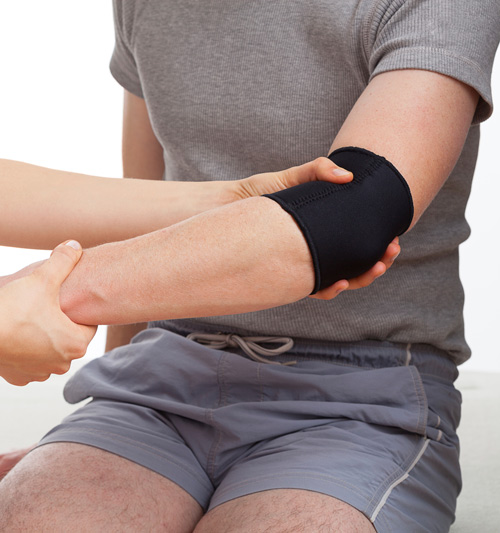Are you cursed by tennis elbow?
Index
Do you play tennis? If you said yes, you’ll know all about the shooting pain, the tightness and the stiffness in your forearm that comes from tennis elbow.

Has tennis elbow has stopped you playing the sport you love? You’re not alone. According to a study by Monash University, 35-57% of all tennis players will suffer from tennis elbow at some stage.
So how do you prevent it? And if you get it, what’s the cure?
How do you get it?
Lateral Epicondylitis, AKA tennis elbow, is caused by wear and tear (literally) of the of arm, forearm and hand muscles. The lateral epicondyle, or the bony bit on the outside of the elbow, gets inflamed at the place where the muscles attach to the bone.
Small tears form in the soft tissue. As a result you feel pain from the elbow right up to the shoulder, and down into the forearm. The pins and needles-like pain can subside with rest and warmth, but a dull ache remains.
Some of the reasons players develop tennis elbow include:
- A lack of strength in the forearm muscles
- A lack of strength in the shoulder muscles
- Instability of the shoulder joint
- Poor technique that puts too much strain on the elbow joint
- Wrong-sized equipment such as racquets or racquet grips
- Repetitive movements of arms and hands
But it’s not just tennis players. Golfers, baseball players, bowlers, gardeners, cleaners – in fact anyone who uses their arms, elbows and wrists repetitively run the risk of developing tennis elbow.
Basically, it happens if you have to hold a heavy object in your hand for a long period. This explains why tradies handling bricks, manual screw drivers or heavy weights are actually more likely to develop the injury than tennis players.
There are two types of onset. You’ll get sudden onset if you play a late backhand and your wrist extensors become strained – this causes micro-tears in the tendon. On the other hand, late onset takes place within 24-72 hours of unaccustomed wrist extension. This could happen whether you’ve been using a new racket, or spent a weekend doing DIY.
How can you prevent it?
It might be boring, but you’ve got to warm up and cool down thoroughly when you play sport. You also have to use the correct (and right-sized) equipment, and use good technique. Your coach can help you with this.
Another tip is to use hand weights to strengthen your arms. Ask a physiotherapist about exercises that can help.
If you’re worried about your risk of developing tennis elbow at work, you should talk to your OHS representative. You need to find a way to avoid or modify those jobs that put extra pressure on your forearm muscles, involve repetitive movements and require awkward postures.
What’s the treatment?
Initially, ice packs. Use them up to six times a day. You also have to rest. Consider using a brace to support the injured muscle.
Then head to your GP or physio to confirm the diagnosis.
When it comes to treatment there is no silver bullet. You’ll probably have to use a combination of treatments. These include laser treatment, anti-inflammatory drugs and pain killers, soft tissue massage and acupuncture.
But the best treatment for elbow pain is a gradual rehabilitation using exercises prescribed by your physiotherapist.
However, if after a year from the initial injury, it appears that all treatments have failed, your doctor may recommend surgery, although this is the last option.
There are nearly 13,000 physiotherapists located right across Australia list in the Yellow Pages. If you are suffering from the effects of tennis elbow, be sure get advice today, to help you get back on the court tomorrow.
